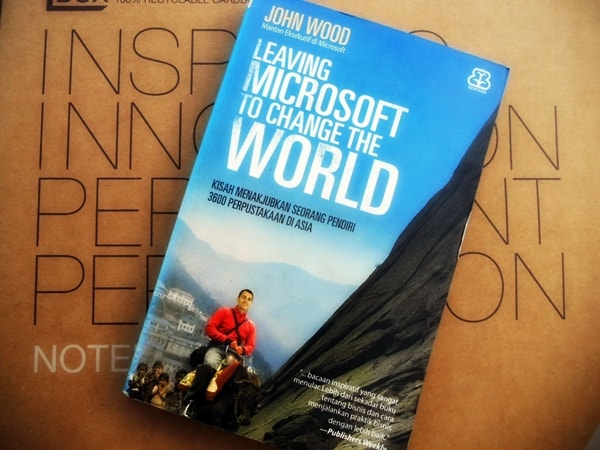When John Wood first visited Nepal in 1998, he was working with Microsoft during the dotcom boom. At one of the fastest growing most successful companies to come out of that period, he was living the dream, working in tech, travelling the world, and making bank. But a three week trip to Nepal, for the longest vacation he’d had in nine years, changed all that.
A chance encounter with an education officer in the area led to him visiting a school where he was given a tour and the Principal proudly showed him the library… which had no books. The few books they had were considered so precious, that they were kept locked up in a cabinet – and were also totally age inappropriate for children. When they parted ways the headmaster said, “Perhaps, sir, you will someday come back with books.”
And from that moment on, John’s focus shifted, moving from the latest tech innovations on to how he could help improve literacy and get reading materials to children in Nepal. Hotmail launched the first free web-based email service in 1996, so by 1998, email was still in its early stages. Nevertheless, John drafted an email and hit “mail all” to his over 100 contacts. This call out pitch led to a crowdfunded project where everyone wanted to chip in and help.
After realising that he was no longer passionate about the work he was doing at Microsoft, John knew that it was time to leave and pursue this passion project full-time. Today, Room to Read Nepal’s literacy and girls education programmes continue to thrive, with 8,691 literacy programme schools and 7,336 girls education participants.
Not comfortable to rest on his laurels, John continued at a frenetic pace, crowdfunding and pitching, creating fundraising chapters across the United States and subsequently the globe. Having been in marketing at Microsoft, he knew plenty of big tech people who were looking to do some good with the windfall from the tech boom.
Perhaps then, more so than now, there was a certain naivety and ignorance about many of the day to day problems in the world. Now, with 24-hour news cycles, social media and the internet at your fingertips, any ignorance at this point is probably wilful; but John found that generally, when you make it easy for people to do good, the more good they’ll do, and with Room to Read he’d hit on a solid idea. It cost X to build a library and Y to build a school, which simply meant that when X or Y amount was raised, donors knew exactly where the money was going.
His savings and shares from Microsoft were enough that he could afford to go without a salary for a while, and he often worked from a nearby coffee shop, so overhead costs were low. This meant that most of the money coming into the organisation went directly into building schools and libraries and funding scholarships for girls.
Based on the successes in Nepal and his travels to other countries, John knew that his work wasn’t over. Room to Read was officially founded in 2000 and today operates in 15 countries across the world. A big part of Room to Read’s success is the integration of local teams, by leaning on the expertise of people who are familiar with the country, culture and community, a lot more can get done and a sustainable model is created.
Looking to start your own project? Here are five key takeaways from the book:
- Be transparent. Not only will this help in showing how you’ve spent/allocated your resources, but being able to showcase the work you’ve done a great selling point for potential donors or people who are otherwise just interested in what you’re doing.
- Don’t let perfect be the enemy of good. If you’re waiting for the right time to do something, you might always be waiting. When the tsunami hit Asia in 2004, it probably wasn’t the best time to consider expanding. But immediately John knew that with a disaster this big, children and their education would suffer as Governments would allocate already limited resources towards medical care, infrastructure and other higher priority areas. Instead of waiting on the perfect moment, John came off his holiday and got into planning mode to help fill a gap where he saw a need.
- Identify the “real” problem. That’s not to say that all problems don’t deserve solutions, but sometimes if you dig a little deeper, you might find that in addressing another issue, you could solve multiple challenges. In many of the Room to Read countries, literacy was a big issue, but within that, girls were at a greater disadvantage in accessing education. However, the benefits of girls being educated are far reaching, not just for the individual, but also for her family, the community and the economy. Room to Read offers scholarships for girls that cover the cost of school fees and also provide uniforms, shoes, backpack and school supplies, health insurance, a bicycle (for transportation to and from school) and a female mentor.
- You can’t do it all alone. As much as John had the drive to get things done, he knew that the magnitude of the problem meant that his singular contributions would never be enough. Knowing how and when to ask for and/or accept help is crucial to any project. This applies to people working directly with you, as well as the stakeholders you hope to impact. Without their buy-in there’s no sustainability.
- Have faith. You are bound to encounter naysayers and people who don’t believe in your ideas. Listen to them, consider what they’re saying, but ultimately, know that you have to believe in the beauty of your dreams. So have faith, and then convince others why they should believe in you and your ideas too.
Image Credit: Toko Buku Acc


